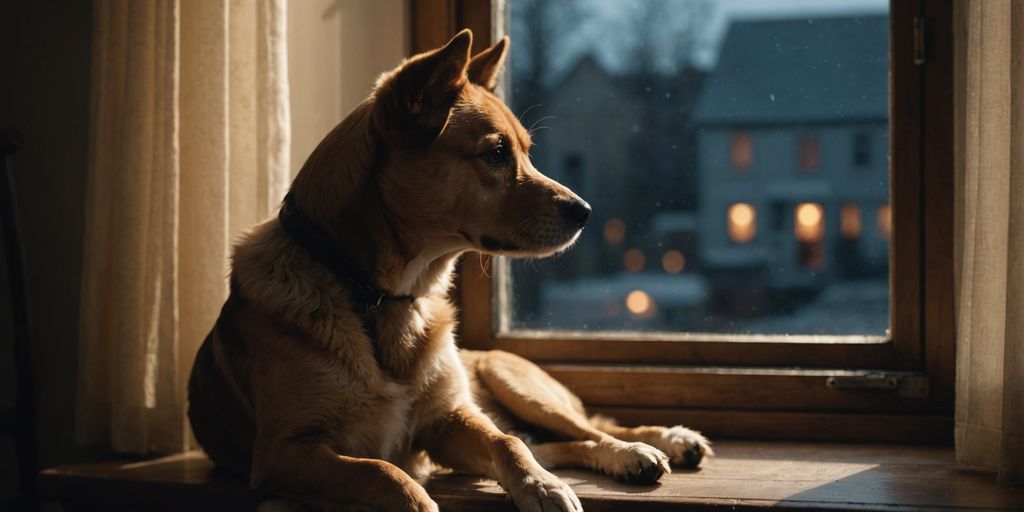Separation anxiety in dogs is a common issue that can cause significant distress for both pets and their owners. Understanding the signs, causes, and effective management strategies is crucial for fostering a happier and healthier relationship with your furry friend. This article will guide you through recognizing the symptoms, understanding the root causes, and implementing practical solutions to manage and prevent separation anxiety in dogs.
Key Takeaways
- Recognizing the signs of separation anxiety, such as excessive barking, destructive behavior, and house soiling, is the first step in addressing the issue.
- Understanding the causes, including early life experiences, changes in routine, and genetic predisposition, can help in tailoring effective management strategies.
- Gradual desensitization, creating a safe space, and using positive reinforcement are key strategies to manage separation anxiety in dogs.
- Training techniques like crate training, establishing a consistent routine, and socialization can help prevent separation anxiety from developing.
- In some cases, seeking professional help from certified trainers or veterinarians may be necessary to effectively address severe separation anxiety.
Recognizing the Signs of Separation Anxiety in Dogs
Separation anxiety in dogs can be tough for both pets and their owners. Knowing the signs is the first step to helping your furry friend feel better when you're not around. Here are some common indicators to watch for:
Common Behavioral Indicators
Dogs with separation anxiety often show certain behaviors that can be quite noticeable:
- Destructive behavior: Chewing furniture, scratching doors, and digging are all ways dogs cope with stress.
- Crying, barking, or whining: This one never goes over well with the neighbors! Even though barking at passersby or the occasional animal is natural, it can become an issue when you are not present to solve these doggy dilemmas.
- Accidents in the house: Even a housetrained dog might have a potty accident when anxiety strikes.
- Restlessness: Pacing, excessive licking, trembling, and panting when left home alone may indicate your dog is feeling uneasy.
- Attempts to escape: Dogs may try to exit through the same door as their pet parents after they leave.
Physical Symptoms to Watch For
Besides behavioral changes, dogs with separation anxiety might also show physical symptoms:
- Excessive salivation or drooling
- Panting more than usual
- Loss of appetite
- Self-harm, like excessive licking or chewing on their own body
When to Seek Professional Help
If you notice these signs, it might be time to get some professional help. Consulting a veterinarian can rule out any underlying medical conditions. A professional trainer or a behaviorist can also provide strategies to manage and reduce your dog's anxiety. Remember, early intervention can make a big difference in your dog's well-being.
Understanding the Causes of Separation Anxiety in Dogs
Early Life Experiences
Dogs that have had traumatic early life experiences, such as being abandoned or separated from their litter too soon, are more likely to develop separation anxiety. These experiences can make them feel insecure and fearful when left alone.
Changes in Routine or Environment
A sudden change in a dog's routine or environment can trigger separation anxiety. This could include moving to a new home, a change in the owner's work schedule, or the loss of a family member. Dogs thrive on consistency, and disruptions can cause them to feel anxious.
Genetic Predisposition
Some dogs may be genetically predisposed to separation anxiety. Certain breeds are more prone to anxiety-related issues, and individual temperament can also play a role. Understanding your dog's genetic background can help you better manage their anxiety.
Effective Strategies to Manage Separation Anxiety
Gradual Desensitization Techniques
One of the most effective ways to manage separation anxiety in dogs is through gradual desensitization. This involves slowly getting your dog used to being alone by starting with short separations and gradually increasing the time. The key is to ensure that your dog remains calm during these periods. If your dog shows signs of anxiety, reduce the time and progress more slowly.
Creating a Safe Space
Instead of using crates, which can sometimes increase anxiety, create a safe space for your dog. This could be a room with windows, toys, and objects that carry your scent, like a piece of clothing. This environment can help your dog feel more secure and less anxious when you're not around.
Using Positive Reinforcement
Positive reinforcement is crucial in managing separation anxiety. Reward your dog for calm behavior and avoid punishing them for anxious actions. This approach not only helps in reducing anxiety but also strengthens the bond between you and your dog.
Remember, managing separation anxiety is a gradual process. Patience and consistency are key to helping your dog feel more comfortable when you're not around.
Training Tips to Prevent Separation Anxiety
Crate Training Benefits
Crate training can be a great way to help your dog feel secure when you're not around. Start by leaving your dog in the crate for short periods while you're home, gradually increasing the time. This helps your dog associate the crate with safety and comfort. Remember, the goal is to make the crate a positive space.
Establishing a Consistent Routine
Dogs thrive on routine. Establish a routine for leaving and returning home at the same times each day. This helps your dog understand that you will always come back. Keep your departures and arrivals calm to avoid reinforcing anxiety.
Socialization and Independence Training
Socializing your dog with other people and pets can reduce anxiety. Encourage your dog to spend time alone in a safe space with toys and treats. This helps them learn that being alone isn't scary.
Training your dog to be less stressed about your departure can make a big difference in preventing separation anxiety.
By following these tips, you can help your dog feel more comfortable and secure when you're not around.
The Role of Exercise and Mental Stimulation
Daily Physical Activities
Exercise is crucial for a dog's well-being. Give your dog at least 30 minutes of aerobic activity like running or swimming every day. This can help them relax and rest when you're not around. Try to exercise your dog right before you leave to help them stay calm.
Interactive Toys and Puzzles
Interactive toys and puzzles are great for keeping your dog mentally stimulated. Food puzzle toys, for example, can be stuffed with treats like peanut butter or cheese. These toys not only keep your dog busy but also have a calming effect.
Benefits of Doggy Daycare
Doggy daycare can be a fantastic option for dogs with separation anxiety. It provides both physical exercise and social interaction with other dogs. This can help reduce anxiety and make your dog happier overall.
Remember, a well-exercised and mentally stimulated dog is less likely to suffer from separation anxiety. Keeping your dog active and engaged is key to their happiness and well-being.
When to Consider Professional Help
Finding a Certified Trainer
If your dog’s separation anxiety is severe, it might be time to seek help from a certified trainer. These professionals have the expertise to create a tailored plan for your dog. Certified trainers can teach you techniques to help your dog feel more comfortable when alone. Look for trainers with experience in dealing with anxiety issues.
Behavioral Therapy Options
Behavioral therapy can be a game-changer for dogs with deep-rooted anxiety. A behavior specialist will work with your dog to modify their response to being alone. This often involves desensitization and counterconditioning techniques. Behavioral therapy helps your dog associate being alone with positive experiences.
Medication as a Last Resort
In some cases, medication might be necessary to help your dog cope with anxiety. Always consult with your veterinarian before starting any medication. Medications can help reduce anxiety levels, making it easier for your dog to handle being alone. However, medication should be considered a last resort and used in conjunction with other treatments.
Remember, seeking professional help is a step towards a happier and healthier life for your dog. Don't hesitate to reach out if you need it.
Building a Stronger Bond with Your Dog
Creating a strong bond with your dog is essential for a happy and healthy relationship. Here are some tips to help you build that connection.
Quality Time Together
Spending quality time with your dog is crucial. Whether it's playing fetch, going for walks, or just cuddling on the couch, these moments help strengthen your bond. Regular quality time can make your dog feel loved and secure.
Understanding Your Dog's Needs
Every dog is unique, and understanding their specific needs is key. Pay attention to their body language and behavior to know what they enjoy and what stresses them out. This understanding will help you create a more harmonious relationship.
Communicating Effectively
Clear communication is vital in any relationship, including the one with your dog. Use consistent commands and positive reinforcement to guide their behavior. This not only helps in training but also builds trust and respect between you and your furry friend.
Remember, patience and understanding go a long way in building a strong bond with your dog. Avoid common mistakes like being inconsistent with rules or neglecting their emotional needs. By focusing on these aspects, you can create a loving and trusting relationship with your pet.
Conclusion
Dealing with separation anxiety in dogs can be tough, but it's totally doable with the right approach. By understanding the signs and triggers, you can help your furry friend feel more secure when you're not around. Remember, patience and consistency are key. Try out different strategies like gradual departures, crate training, and plenty of exercise to see what works best for your dog. And don't hesitate to seek professional help if needed. With time and effort, you can turn those anxious moments into calm and happy times for both you and your dog. So, hang in there and keep working towards a stress-free life for your pup!
Frequently Asked Questions
What are the common signs of separation anxiety in dogs?
Common signs include excessive barking, destructive behavior, house soiling, pacing, restlessness, and attempts to escape.
Why do some dogs develop separation anxiety?
Dogs may develop separation anxiety due to early life experiences, changes in their routine or environment, or even genetic factors. Rescue dogs or those with a history of trauma are more prone to this condition.
How can I help my dog feel more comfortable when I'm not home?
You can help your dog by using gradual desensitization techniques, creating a safe space, and using positive reinforcement when they stay calm during your absence.
What are some effective strategies to manage separation anxiety in dogs?
Effective strategies include crate training, establishing a consistent routine, and ensuring your dog gets plenty of exercise and mental stimulation.
When should I seek professional help for my dog's separation anxiety?
If your dog's anxiety is severe or if the strategies you've tried aren't working, it might be time to seek help from a certified trainer or a veterinarian who can suggest behavioral therapy or medication.
Can exercise help reduce my dog's separation anxiety?
Yes, regular exercise and mental stimulation can help reduce anxiety by tiring your dog out and providing a positive outlet for their energy.


